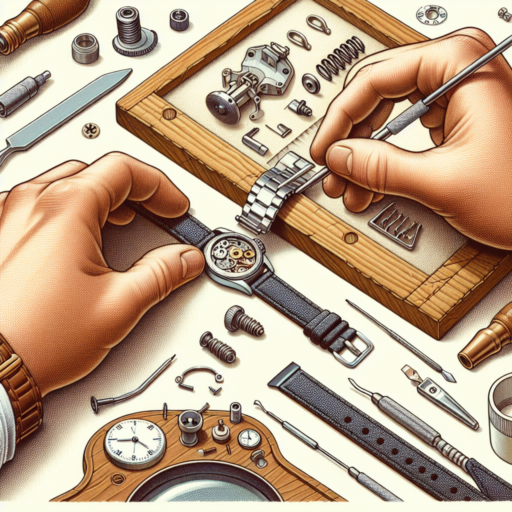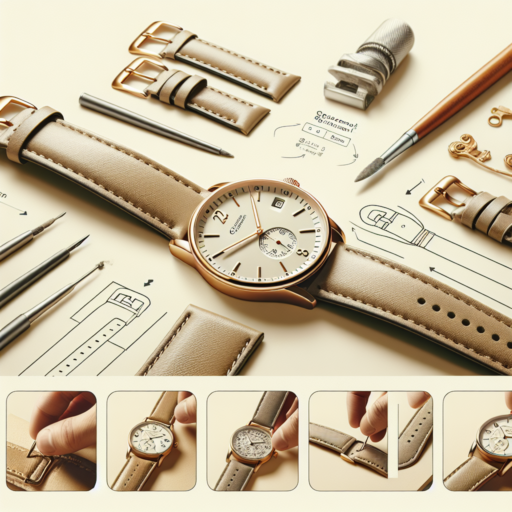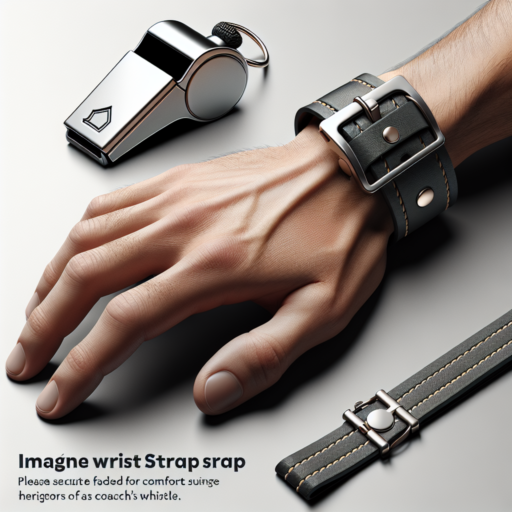Step-by-Step Guide to Watch Band Removal
Removing a watch band might seem daunting at first, especially if you’re doing it for the first time. However, with the right tools and a bit of patience, you can easily switch out your watch band to give your timepiece a fresh look or to replace a worn-out strap. This guide will lead you through the process, ensuring a smooth and secure removal of your watch band.
Prepare Your Tools
Before you begin, it’s important to gather all the necessary tools. You’ll typically need a spring bar tool, a small screwdriver, or a pin removal tool, depending on the type of watch band you’re dealing with. Laying out a soft cloth on your work surface can also help prevent scratching your watch. Ensuring you have the right tools at hand will not only make the process easier but will also minimize the risk of damaging your watch or its band.
Identify the Band Attachment
Watch bands are attached in several ways, so it’s crucial to identify the mechanism your watch uses. The most common types include spring bars and screws. Spring bars require you to use a spring bar tool to compress them and release the strap. Screws, on the other hand, necessitate a small screwdriver to remove them. Recognizing the attachment type will guide you on which tool to use and how to proceed with the removal.
Removing the Watch Band
Once you’ve identified the attachment type and have your tools ready, gently insert the spring bar tool or screwdriver into the relevant area. For spring bars, aim to push or pull against the ridged part of the bar until it compresses enough to free one end from the lug. If dealing with screws, carefully unscrew and keep them in a safe place. Applying gentle pressure is key to avoiding any damage. After detaching one side, repeat the process on the other to fully remove the band. Remember, patience and gentle handling are your best allies in this task.
Essential Tools You Need for Removing Watch Bands
When it comes to updating or replacing your watch band, having the right tools at hand can transform a complicated task into a simple, swift operation. These essential tools are designed to cater to a variety of watch types, ensuring a safe and efficient removal process without damaging your precious timepiece.
Spring Bar Tool
The spring bar tool is a must-have for anyone looking to remove or adjust their watch bands. Its precise tips allow for easy manipulation of the spring bars, which are the mechanisms holding your watch band in place. Most spring bar tools come with a forked tip at one end and a pointed tip on the other, making it versatile for both removal and installation purposes.
Case Back Opener
For watches with bands that attach directly to the case, a case back opener becomes indispensable. This tool helps safely open the watch back without scratching or damaging it, providing access to the inner workings of the watch for a thorough and proper band removal or maintenance. Case back openers come in various sizes and shapes to accommodate different watch types, ensuring you can find the right fit for your timepiece.
Common Mistakes to Avoid When Removing Watch Bands
Removing a watch band might seem like a straightforward task, yet it’s fraught with potential pitfalls that can damage your watch or the band itself. Recognizing and understanding these common mistakes can save you time, money, and preserve the integrity of your precious timepiece.
Using Incorrect Tools
One of the most frequent errors is the use of improper tools when attempting to remove a watch band. Utilizing makeshift tools not designed for watch repair, such as knives or screwdrivers, can not only scratch the case or the band but also lead to personal injury. It is crucial to use the correct watch tools, designed specifically for the task at hand, to avoid unnecessary harm to your watch.
Applying Excessive Force
Another common mistake to be wary of is applying too much force. Whether it’s pushing, pulling, or twisting, excessive force can damage both the watch band and the watch itself. This often happens when individuals are not familiar with the band’s mechanism or when they become frustrated with a band that’s difficult to remove. Gentle and patient manipulation, possibly with the right lubrication, is key to avoiding damage.
Not Securing the Watch Properly
Last but not least, failing to secure the watch properly while trying to remove the band is a setup for a mishap. Working on a watch without stabilizing it can lead to the watch slipping, falling, and getting scratched or worse. It’s advisable to use a padded mat or a secure holder to ensure the watch stays in place during the operation. This simple step can prevent a multitude of problems.
How to Remove Different Types of Watch Bands
Removing a watch band can be a nerve-wracking experience, especially if you’re doing it for the first time. However, with the right tools and techniques, it’s a task that can be accomplished with ease. Whether you’re looking to swap your watch band for a new style, or it needs a repair, understanding how to remove various types of watch bands is essential. Below, we dive into the simple steps to help you confidently remove different kinds of watch bands without the fear of damaging your cherished timepiece.
Removing Pin-type Bands
The most common type of watch band fastening is the pin type, which utilizes small pins to hold the band in place. To remove a pin-type watch band, you will need a pin removal tool or a small precision screwdriver. Firstly, locate the small holes on the side of the watch where the band is attached. Gently insert the tool into one of these holes and apply pressure until the pin is dislodged. Repeat the process on the other side of the band. It is crucial to work on a flat surface to avoid losing the small pins.
Separating Screw-type Bands
Watches that boast a more robust design often come with screw-type bands. Removing these involves using a small screwdriver that matches the head of the screws. Find the screw heads on either side of the band’s linkage and carefully unscrew them. It’s essential to keep the screws in a safe place after removal, as they are incredibly tiny and easy to lose. Once all screws are out, the band should come apart easily. Practicing patience during this process is key to avoiding damage to the screws or the watch itself.
Mastering the method of removing your watch band not only broadens your accessory options but also empowers you to handle minor repairs and maintenance. Remember, each type of watch band presents its own set of challenges, but with the right tools and a steady hand, you can become proficient in swapping out your bands to suit your style or servicing needs.
Tips for Safely Removing Your Watch Band Without Damaging Your Watch
Removing your watch band, whether for cleaning, repair, or replacement, can feel daunting. The fear of damaging your watch is legitimate but with the right techniques and tools, you can perform this task safely and efficiently. Here, we outline practical tips to ensure that your timepiece remains in pristine condition during the band removal process.
Use the Right Tools
For starters, using the correct tools is critical. A spring bar tool, designed specifically for watch band removal, can prevent scratches and ensure you’re exerting pressure correctly. Avoid using makeshift items like knives or screwdrivers, which can slip and cause damage. If you’re working on a smartwatch or a model with a different fastening mechanism, ensure you have the appropriate screwdrivers or tools recommended by the watch manufacturer.
Prepare Your Workspace
Next, it’s essential to prepare your workspace. Ensure that the surface is soft and scratch-resistant by laying down a microfiber cloth or a soft mat. Having good lighting will help you see what you are doing more clearly, reducing the chance of mishaps. Additionally, keep a small tray or cup at hand to hold any tiny parts like screws or spring bars, minimizing the risk of losing them during removal.
Be Gentle and Patient
Perhaps the most critical advice is to be gentle and patient. Rushing the process or using excessive force can bend pins, damage the watch case, or tear the band. Take your time to carefully align and use the tools, applying steady and gentle pressure. If you encounter resistance, double-check that you’re applying force in the correct direction and that you’re using the right tool for your type of watch band.
DIY Watch Band Removal Vs. Professional Services: What’s Best for You?
Deciding between DIY watch band removal and opting for professional services involves weighing the pros and cons of each approach. For watch enthusiasts and casual owners alike, choosing the right method can significantly impact the life span and appearance of your timepiece. The quest for the perfect solution entails understanding the intricacies of both options.
DIY watch band removal offers a sense of accomplishment and can be a cost-effective solution for those comfortable with the risk and equipped with the right tools. It allows watch owners to explore their mechanical curiosity and gain a deeper appreciation for their timepieces. However, the risk of damaging your watch or voiding its warranty can not be overlooked. Precise tools and a steady hand are crucial for this task to ensure the safety of both the watch band and the watch itself.
On the flip side, professional services guarantee expert care and a risk-free process. Qualified technicians possess the necessary experience and tools to handle various types of watch bands and mechanisms. Their expertise minimizes the risk of damage and ensures that the removal process does not compromise the watch’s functionality. Although this option comes with a cost, investing in professional services can save you from potential expensive repairs or the need to replace a damaged watch band.
No se han encontrado productos.
Aftercare Tips: What to Do After Removing Your Watch Band
Once you have carefully removed your watch band, it’s essential to follow some aftercare procedures to ensure both your watch and its band maintain their quality and functionality. The care you provide after detaching your watch band can significantly impact its longevity and appearance.
Cleaning the Band and Watch
Start with a gentle cleaning of the band. If it’s a leather band, use a soft, damp cloth with a mild soap solution. For metal bands, a jewelry cleaner or a mix of water and a tiny amount of dish soap will do. Use a soft brush to get into crevices. Remember to dry it thoroughly afterwards. The watch itself may only need a wipe down, but ensure no water seeps into its mechanics. Avoid using harsh chemicals on both the watch and band.
Inspect for Wear and Tear
After cleaning, closely inspect your watch band and the watch for any signs of wear and tear. Look for any rips in leather, stretched links in metal bands, or loose fittings that could indicate it’s time for a repair or replacement. This is also an excellent time to check the watch’s back and attachment points for any damage. Addressing these issues early can prolong the life of your watch and band.
Finally, storing your watch and band properly is crucial. A soft, dry place away from direct sunlight or humidity is ideal. For leather bands, consider a breathable pouch, while metal bands can be stored in a felt-lined box to prevent scratches. Taking these aftercare steps seriously can keep your watch in optimal condition, ready for its next wear.
Troubleshooting Guide for Watch Band Removal Challenges
Sure, focusing solely on the H2 topic regarding watch band removal challenges, a SEO-focused content might look something like this:
Encountering difficulties with watch band removal is not uncommon, whether you’re adjusting the fit, replacing a worn-out strap, or upgrading to a new style. The correct approach can vary widely depending on the type of watch and band. This guide aims to navigate you through common hurdles, ensuring a smoother, damage-free removal process.
Identify Your Watch Band Type
Before proceeding, it’s crucial to identify your watch band type. Bands can be secured with pins, screws, or a quick-release mechanism. Each type requires a different tool and technique for removal. For instance, bands with pins may need a pin removal tool or a small screwdriver, while those with screws necessitate precision screwdrivers.
Common Removal Issues and Solutions
- Stuck pins: Lubricate the area with a tiny drop of oil before attempting removal again. A pin pusher tool is preferable for added leverage.
- Stripped screws: Apply a small amount of rubber band over the screw head, then try again with the screwdriver. The rubber provides extra grip.
- Fragile linkages: Work on a soft, padded surface and use minimal force to prevent bending or breaking the band’s delicate links.
Having the right tools and knowledge can significantly mitigate the frustration involved in watch band removal. Patiently identifying your band type and applying the appropriate solution greatly enhances the chance of a successful adjustment or replacement without resorting to professional help.
How to Choose a New Watch Band After Removal
Choosing a new watch band after removal can feel like a daunting task, but with the right guidance, it can also be an exciting opportunity to refresh the look of your beloved timepiece. When selecting a new strap, consider the material, compatibility, and style that best suit your daily needs and personal aesthetics.
Understand the Material Options
Watch bands come in a variety of materials, each offering its own set of benefits. Leather straps provide a classic and sophisticated look, ideal for formal occasions or professional settings. Silicone and rubber bands, on the other hand, offer durability and water resistance, making them perfect for sports or outdoor activities. For those seeking a blend of durability and style, metal bracelets and nylon straps might be the go-to options.
Ensure Compatibility with Your Watch
It’s crucial to ensure that the new band is compatible with your watch. This means checking the band’s size and the lug width of your watch. Most watch bands specify their size in millimeters (mm), making it relatively straightforward to find a perfect fit. Additionally, pay attention to the attachment mechanism; some straps require specific tools or connectors for installation.
Reflecting on your lifestyle and personal style will significantly influence your decision when choosing a new watch band. By considering the material, ensuring compatibility, and thinking about the strap’s overall look, you can find a band that not only revives your watch but also complements your style perfectly.
Frequently Asked Questions About Watch Band Removal
Removing a watch band can seem daunting, especially for those who are doing it for the first time. Many watch owners have questions about this process, whether they’re looking to swap out their band for a fresh look or need to replace a worn-out strap. The most common inquiries revolve around the tools required, the risk of damaging the watch, and the specific steps for different types of bands. Below, we address these concerns to help simplify watch band removal.
What Tools Do I Need for Watch Band Removal?
The tools needed for removing a watch band largely depend on the type of band and the watch’s construction. For most standard watches, a simple spring bar tool is sufficient. This tool helps in compressing the spring bar pins, allowing you to easily remove the band. For watches with a more complex mechanism or for metal bands, you might also need a small screwdriver or a pin removal tool. It’s important to use the right tools to avoid accidentally scratching the watch case or damaging the band.
Is There a Risk of Damaging My Watch?
One of the biggest concerns watch owners have is the risk of damaging their precious timepiece during the band removal process. While there is always a small risk, using the correct tools and following the proper steps can minimize it. Ensuring that you work on a soft, clean surface and keep your tools in good condition will also help prevent any unwanted scratches or damage. Taking your time and not forcing any parts will further reduce the likelihood of harming your watch.
How Do I Remove Different Types of Watch Bands?
Different types of watch bands require specific approaches for removal. Leather and fabric straps often use spring bars that can be released with a spring bar tool. Metal bands may have links that are pinned or screwed together, necessitating a pin removal tool or a screwdriver. For smartwatch bands, the mechanism varies by brand but usually involves some form of button or lever release. It’s crucial to familiarize yourself with your watch’s band type and removal method to ensure a smooth process.




